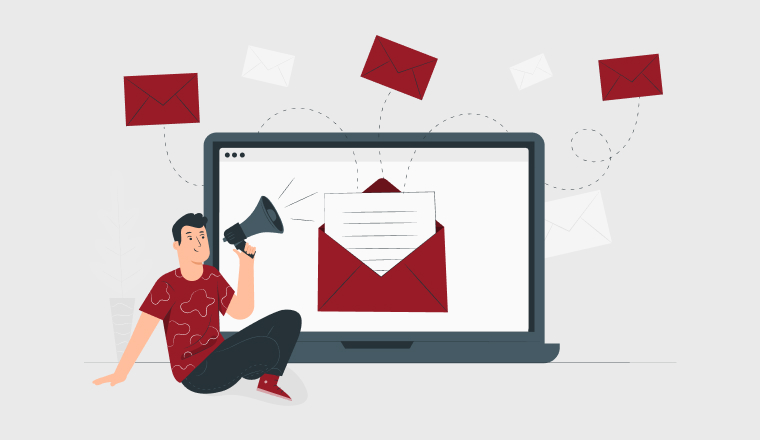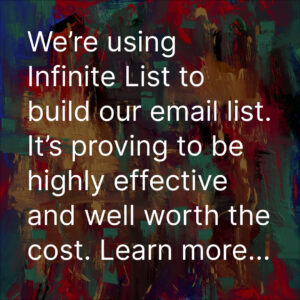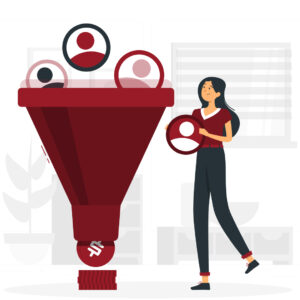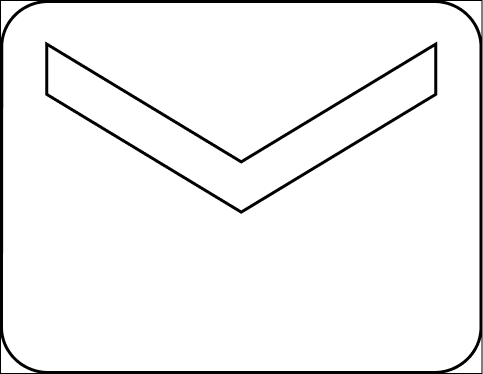Your cart is currently empty!

Unlock the Power of Email Marketing for Your Business
Reading Time: 19 minutesAuthor:
Your email list is one of only two digital assets your business owns. (The other one is your website.)
Using email marketing is not just a wise choice; it’s a necessary one. It is essential for almost all businesses because it’s a cost-effective way to nurture customer relationships and generate sales.
Targeting is the key to effective and efficient email marketing. For example, consider RFM targeting. I’ve previously written about RFM (Recency, Frequency, and Monetary) customer segmentation. The underlying idea is that the customer who bought from you most recently, who buys from you most frequently, and who spends the most money with you is the customer most likely to purchase from you again. Email marketing is your first choice to reach these prime prospects for what you are selling.
How else might email marketing benefit your company, and how does it fit into your overall digital strategy?
Throughout this article, I’m drawing from my many years of email marketing experience to show you its potential and describe how you can use email marketing to drive your business forward.
I’ll discuss:
- The cost-effectiveness of email campaigns compared to other marketing methods.
- How you can use email marketing to build strong customer relationships through personalization.
- How email marketing can boost brand loyalty, nurture and convert leads, and
- I’ll describe how email marketing can seamlessly integrate with other marketing tactics to create a powerful and cohesive strategy.
But wait, there’s more.
I’ll also look at the importance of analyzing and measuring your email campaigns’ success and automation’s role in streamlining your email marketing efforts.
Additionally, I’ll address the legal and ethical considerations surrounding email marketing and explain how to ensure that your campaigns comply with the law and respect your subscribers’ privacy.
Whether you’re new to email marketing or looking to optimize your existing strategy, this article will equip you with the knowledge and tools necessary to harness the power of email to take your business to new heights.
So, let’s dive in and explore how email marketing can become the secret weapon that propels your business forward in the digital landscape.

What is Email Marketing?
At its core, email marketing is online direct marketing. It involves sending targeted, personalized emails to a list of subscribers who have opted in to receive communications from your business. This permission-based approach separates email marketing from traditional direct marketing. It allows you to nurture relationships with your customers and prospects by keeping them engaged with your brand and informed about your products, services, and promotions.
Email marketing leverages your email list, a valuable collection of contact information from individuals who have expressed interest in your business. These subscribers have given you permission to send them relevant content. I cannot overemphasize this. People on your list have asked to hear from you. Take advantage of this, but equally, don’t abuse what you’ve been given.

By crafting compelling email campaigns that resonate with your subscribers’ interests and needs, you can build trust, drive engagement, and ultimately convert them into loyal customers. The 70:20:10 formula is a good rule of thumb to follow: 70% of the content in your emails should be value-focused, 20% is curated content you believe your audience will value, and 10% is sales-focused.
This post focuses on why you should use email marketing and provides some direction on how to do so. For an excellent, in-depth guide on the ‘how to,’ especially as it relates to email newsletters, I recommend you read Anne Handly’s post: 17 NON-NEGOTIABLE THINGS YOUR EMAIL NEWSLETTER NEEDS RIGHT NOW.
But how does email marketing fit into your overall digital strategy?
The answer is simple: seamlessly.
Email marketing can complement and enhance all your digital marketing efforts. In this post, Business Email Best Practices, we cover the key things. Integrating email marketing into your digital strategy changes what you do from a speech to a conversation.
For instance, you can use social media to grow your email list by promoting lead magnets and using opt-in forms to capture email addresses. Then, you can use email to distribute your valuable content, such as your blog posts, curated content from other resources, and anything else that provides value to your subscribers. Remember the 70:20:10 rule I described above. A value-first conversation builds trust with prospects and customers and establishes your business as a thought leader in your industry.
Moreover, segmenting your audience based on various criteria, such as demographics, interests, or past behavioral trends, allows you to refine your messaging, further increasing the value your audience perceives.
Get the right message to the right person at the right time.
Direct Marketing Axiom
Email marketing is a powerful, permission-based strategy that allows you to connect with your target audience directly and meaningfully. Integrating email marketing into your digital strategy creates a cohesive, practical, low-cost channel that nurtures relationships, drives engagement, and ultimately contributes to your business’s growth and success.
Now, let’s get into some of the details.
Email Marketing Makes Financial Sense
As a business owner, you want to maximize the impact of your marketing budget and achieve the best possible return on investment (ROI). This is where email marketing truly shines. Email consistently delivers exceptional cost-effectiveness compared to other forms of marketing. This is especially true when combined with other channels. More on this below.
Let’s consider some common marketing channels and their associated costs. Traditional methods, such as print advertising, television commercials, or direct mail campaigns, require substantial production, distribution, and media placement investments.
In contrast, email marketing is a much more affordable alternative. With email, there are no printing or postage costs, and you don’t need to pay for advertising space.
The primary expenses associated with email marketing are typically related to the email service provider (ESP) you choose, which offers tools for creating, sending, and managing your campaigns. Most ESPs offer flexible pricing plans based on the size of your email list and the features you require, making it easy to find a solution that fits your budget.

We use and recommend MailChimp. It has all the functionality our clients need, and our content specialists are trained in the platform, so we can provide support when you need it. For more about MailChimp, read our post Email Mastery: How to Create a Newsletter in Mailchimp that Shines.

There may be some additional expenses for list building, copywriting, and design, but this does not compare to the investments required for traditional channels. And some of these potential expenses may be optional.
For example, your authentic voice is often more than enough with email copy. In fact, your audience will appreciate your emails more because, in their simplicity, they stand out from the slick professional missives clogging the average inbox.
Finally, the financial impact of email marketing goes beyond its affordability. When executed properly, email campaigns generate results. According to a study by the Direct Marketing Association, email marketing delivers an average ROI of $42 for every $1 spent. This means you can expect an average return of $42 for every dollar you invest in email marketing.
Several factors contribute to the high ROI of email marketing. In addition to a lower cost base, email allows you to reach an audience that asked to hear from you. By segmenting your email list based on criteria important to your business, things like demographics, list source, interests, or behavior (link clicks, past purchases, etc.), you ensure that your messages reach the right people at the right time. Targeting through segmentation leads to higher engagement rates, more conversions, and, ultimately, better ROI.
Second, email marketing is highly measurable. With the tools and analytics provided by the ESP, you can track the real-time performance of your campaigns, gaining valuable insights into open rates, click-through rates, conversions, and more.
When you add UTM tracking codes to the links in your emails, you can also use Google Analytics to track visitor behavior on your website.
You can also use email marketing to split test headlines and offers. The feedback is almost immediate, and the cost is negligible.
I hope you see how email marketing offers unparalleled value for your business. With its low costs and high efficiency, email provides an excellent opportunity to maximize your marketing impact and achieve your business goals. By investing in email marketing, you have an affordable way to have conversations with your audience, creating trust and boosting your bottom line.
Building Relationships through Email Marketing

One of the most significant advantages of email marketing is its ability to foster solid and long-lasting relationships with your customers and prospects.
90% of loyalty problems can be traced to a flawed sales process.
James’ism
Building genuine connections with your audience is essential for driving loyalty, retention, and success in today’s competitive business landscape. Email marketing provides the perfect platform for nurturing these relationships through personalization, value delivery, and customer engagement.
Personalization is critical to creating emails that resonate with your subscribers. By leveraging the data you collect about your audience, such as their names, interests, and past behavior, you can craft messages that speak directly to their needs and preferences. This level of personalization goes beyond simply inserting a subscriber’s name into the subject line; it involves tailoring the content, offers, and tone of your emails to match each audience segment’s unique characteristics and needs.
For example, you should use a different tone of voice for prospects and customers. Customers have a relationship with you. Speak to them as if you are talking to someone you know. Prospects are building trust with you. Speak to them like they don’t know you but should.
Here’s another example: imagine you own an online store that sells outdoor gear. By segmenting your email list based on past purchases, you can send unique emails to different groups of customers. For those who have previously bought hiking boots, you can send an email featuring your latest collection of hiking gear and tips for planning the perfect hiking trip. For customers interested in camping equipment, you can email a curated selection of tents, sleeping bags, and cooking essentials, along with a unique discount code for their next purchase.
Another example, drawn from my past in tourism, uses link clicks to create user segments. In this case, send a new subscriber a general newsletter incorporating several subject areas. These might be golf courses, spas, outdoor adventures, or leisure destinations. Then, use the links clicked to move the subscriber into interest segments. If they click a golf link, the next newsletter they receive will be about golf. You get the idea.
This level of personalization demonstrates that you understand and value your customers’ interests, which goes a long way in building trust and loyalty. It also increases open rates and engagement rates.
The value delivered goes beyond transactional benefits. The value delivered builds relationship equity, which separates your brand from the competition. When your subscribers feel that your emails are relevant and valuable, they’re more likely to engage with your content, visit your website, and purchase.
Another way to build relationships through email marketing is by encouraging customer engagement. Invite your subscribers to provide their feedback, opinions, or user-generated content. For instance, you can send a post-purchase email asking customers to leave a review of the product they bought or share a photo of themselves using it on social media. If they use a specific hashtag, you can reward them with a coupon for a future purchase. By involving your customers in your brand’s story, you create a sense of community and belonging that strengthens their connection to your business.

Real-life examples and case studies demonstrate the power of personalization and engagement in email marketing. An example of this is Sephora, a beauty brand. Sephora’s email strategy involves segmenting its list based on skin type, beauty concerns, and purchase history. By sending highly targeted emails with personalized product recommendations, tutorials, and exclusive offers, Sephora creates a highly engaging email experience that keeps customers returning for more.
Another notable example is the outdoor clothing company Patagonia. Patagonia uses email to share stories about environmental activism, outdoor adventures, and the people behind its products. Stories like this foster an emotional connection with their audience. Patagonia gains loyalty and advocacy by focusing on content that aligns with its customers’ values and interests.
In both examples, the marketers used email to deliver value to customers. Email marketing is a powerful way to build deep and lasting relationships with your customers and prospects. By prioritizing personalization and value over sales, you can create email campaigns that resonate with your audience, foster loyalty, and drive long-term success for your business. Remember, the key to building relationships through email is delivering value, understanding your customers’ needs, and creating a sense of community around your brand.
Enhancing Brand Recognition
In our noisy world, standing out from the competition and establishing a strong, recognizable brand is more important than ever. A brand has a relationship with its customers and vice versa. Relationships develop through conversations and the exchange of value. Email marketing provides a cost-effective channel for building and reinforcing your brand, helping you create a lasting impression in the minds of your customers and prospects.
Consistency is King

One key way email marketing enhances brand recognition is through messaging consistency. Every email you send is an opportunity to showcase your brand’s personality, values, and unique selling proposition. Maintaining a consistent tone, visual style, and messaging across all your email campaigns creates a cohesive brand experience that reinforces your identity and sets you apart from the competition.
This consistency extends to the design elements of your emails, such as your logo, color scheme, and typography. Using the same visual elements across your emails creates a strong, recognizable visual brand that subscribers associate with your business. Over time, this consistent branding helps to build trust and familiarity with your audience, making them more likely to engage with your content and, ultimately, do business with you.
Showcase Your Knowledge
Another way email marketing enhances brand recognition is by allowing you to showcase your expertise and thought leadership. Regularly sharing valuable, informative content with your subscribers positions your business as a trusted authority in your industry. This could include blog posts, summits and events, case studies, or other resources demonstrating your knowledge and providing value to your audience.
Establishing your business as a go-to source for information and insights enhances brand recognition and builds credibility and trust with your subscribers. When your audience trusts your expertise, they’re more likely to turn to you when they’re ready to purchase or recommend your business to others.
Integration is Queen
To maximize the brand-building potential of your email marketing, be sure to integrate your email campaigns with your other marketing channels, such as your website, social media, and offline marketing efforts. By presenting a unified brand experience across all touchpoints, you create a stronger, more memorable impression in the minds of your customers and prospects. Integration is important, so there’s more about it later in this article.
Email marketing is a powerful tool for enhancing brand recognition and building a strong, memorable brand identity. By maintaining consistency in your messaging, personality, and visual branding and showcasing your expertise and thought leadership in your email campaigns, you create a lasting impression in the minds of your subscribers. As you build trust, credibility, and emotional connections with your audience through email, you lay the foundation for long-term success and growth for your business.
Nurturing and Converting Leads

Email marketing is crucial in nurturing and converting leads into paying customers. By strategically using email campaigns, you can support prospects through the marketing funnel, addressing their unique needs and concerns at each stage of the buyer’s journey.
Email lead nurturing builds trust with potential customers who have shown interest in your products or services before they buy.
Email marketing lets you stay top-of-mind with these prospects, providing valuable information and gradually guiding them toward a purchase decision.
Some effective tactics for nurturing leads with email include:
- Send targeted, personalized content based on a lead’s interests, behavior, or position in the marketing funnel.
- Offer educational resources that address common questions and pain points, such as e-books, masterclasses, or webinars.
- Provide case studies, success stories, or testimonials that demonstrate the value of your products or services.
- Invite leads to engage with your brand through surveys, polls, or other interactive content.
By consistently delivering value and building trust with your leads, you increase the likelihood that they will choose your business when they’re ready to purchase. And when they purchase, they are doing so for the right reasons. This gives you a head start on building loyalty. Remember, the most important purchase isn’t the first purchase; it’s the second.
Once a lead has been nurtured and is ready to take action, email marketing can be a powerful tool for driving conversions. By crafting compelling, action-oriented email campaigns, you can encourage leads to take the next step, whether purchasing, scheduling a consultation, or signing up for a free trial. And because you’ve worked hard to build a relationship with your prospects, it stops being a sale in their minds and becomes the next logical step in their journey. How cool is that!
Some tactics for improving conversion rates through email include:
- Creating a sense of urgency or scarcity with limited-time offers or exclusive promotions.
- Using clear, compelling calls-to-action (CTAs) that guide leads toward the desired action.
- Segment your email list based on lead behavior or their stage in the marketing funnel and send targeted campaigns that address their specific needs.
- Optimize your email design and copy for mobile devices to ensure a seamless, user-friendly experience.
- Leveraging automation to send timely, relevant emails based on a lead’s actions or inaction.
By implementing these tactics, you can effectively use email marketing to convert leads into customers and drive revenue for your business in the short term and the long term.
It’s important to remember that lead nurturing and conversion work together. Your conversion emails will be more compelling if you first provide value and build trust. Guiding and supporting prospects through the marketing funnel will ultimately drive more sales for your business.
Integrating with Other Marketing Tactics
Email marketing is clearly a powerful tool, but its true potential is unlocked when it’s integrated with other marketing channels and tactics. By creating a cohesive, multi-channel marketing strategy that uses email alongside other methods, you can make a more engaging, immersive experience for your audience and drive better results for your business.
One highly effective way to integrate email marketing with other channels is through a quiz funnel. This innovative tactic combines quizzes’ engaging, interactive nature with the nurturing and conversion power of email marketing to guide prospects through the marketing funnel and ultimately drive more conversions.

Here’s how a quiz funnel works:
1. Attract leads with a fun, engaging quiz
- Create a quiz that appeals to your target audience and aligns with your brand, such as “What’s Your Travel Style?” for a travel agency or “What’s Your Skin Type?” for a skincare brand.
- Promote the quiz across your marketing channels, such as social media or paid advertising, to attract a wider audience and drive traffic to your quiz landing page.
2. Capture email addresses
- Participants must provide their email addresses to access their quiz results, which allows you to capture valuable lead information and grow your email list.
3. Deliver personalized quiz results via email
- Use email to deliver each participant’s quiz results and personalized content or insights based on their responses.
- This targeted, personalized approach helps to build trust and establish your brand as a valuable resource in your industry.
- Insert a pro tip about using a link rather than attaching the results.
4. Nurture leads with an email automation
- Follow up with quiz participants using an email series that provides additional value, such as related content, product recommendations, or special offers.
- Use segmentation and personalization to ensure that each email is relevant and engaging to the individual recipient based on their quiz responses and behavior.
5. Convert leads with a qualifying assessment
- As a final step in the quiz funnel, invite leads to take a more in-depth qualifying assessment to help determine their fit for your products or services.
- Completing a well-written assessment survey will often convince qualified prospects that your solution is the only solution they should consider.
- Stream non-qualified prospects into other offers like a masterclass or email course.
Use the assessment survey results to tailor your sales approach and create a more personalized, effective conversion strategy.
Integrating email marketing into a quiz funnel creates a more engaging, interactive experience for your audience while gathering valuable data and insights to inform your marketing efforts. This multi-channel approach allows you to guide prospects through the marketing funnel more naturally and personally, building trust and driving conversions for the right reasons.
Beyond quiz funnels, there are countless other ways to integrate email marketing with your other marketing channels. For example, you can use social media to promote your email newsletter and grow your subscriber list or use email to drive traffic to your blog or website. By creating a cohesive, integrated marketing strategy that leverages the strengths of each channel, you can make a more powerful, effective marketing machine that drives actual results for your business.
Analytics and Feedback
Measurement is crucial for understanding what’s working and what’s not and optimizing marketing efforts.
Email marketing analytics provide a wealth of data on how your subscribers interact with your emails. Key metrics to track include:
- Open rates: The percentage of subscribers who open your emails
- Click-through rates (CTR): The percentage of subscribers who click on links within your emails
- Conversion rates: The percentage of subscribers who take a desired action, such as making a purchase or filling out a form
- Bounce rates: The percentage of emails that fail to deliver due to invalid or closed email addresses
- Unsubscribe rates: The percentage of subscribers who opt out of receiving future emails from your brand

Water the flowers and prune the weeds
By regularly monitoring these metrics, you can identify trends and patterns in your email performance. For example, if you notice that certain subject lines or content consistently generate higher open rates, you can use this insight to optimize future campaigns. Similarly, suppose that a particular segment of your audience has a higher CTR or conversion rate. In that case, you can focus on creating targeted campaigns that resonate with this group.
In addition to tracking quantitative data, gathering qualitative feedback from your subscribers is equally important. Surveys, polls, and other feedback mechanisms allow you to hear directly from your audience about what they like, dislike, and want to see more of in your email campaigns. This valuable insight can help refine your email strategy to meet your subscribers’ needs and preferences better.
Many tools and platforms are available to help you track email marketing analytics and gather subscriber feedback. Most email service providers (ESPs) offer built-in analytics dashboards that provide real-time data on your email performance. These dashboards typically include visual representations of key metrics and the ability to drill down into specific campaigns or segments for more detailed analysis.
In addition to ESP analytics, third-party tools can provide even more advanced tracking and analysis capabilities. For example, you can use Google Analytics and UTM tracking codes to track website behavior and conversions, and email heat mapping tools can show how subscribers visually interact with your emails.
When gathering feedback, tools like MailChimp Surveys and SurveyMonkey make creating and distributing surveys to your email list easy. You can also use more informal methods, such as asking subscribers to reply to your emails with their thoughts or opinions.
Gathering analytics and feedback data is essential for optimizing and improving email marketing efforts. Regular reporting and analysis should be a key part of this process, allowing you to identify areas for improvement and make data-driven decisions about your strategy.
By combining quantitative analytics data with qualitative subscriber feedback, you can understand how your email campaigns are performing and how you can optimize them for better results. Whether you want to increase open rates, drive more conversions, or create a more engaging experience for your subscribers, analytics and feedback are essential for email marketing success.
Overcoming Challenges in Email Marketing
While email marketing can be a highly effective way to connect with your audience and drive business results, it’s not perfect. (Only my wife is perfect.)
Many potential obstacles can impact your email campaigns’ successes, from high bounce rates and unsubscribes to disengaged subscribers and deliverability issues. However, by understanding these challenges and implementing strategies to overcome them, you can ensure that your email marketing efforts remain effective and impactful. Email marketing is not ‘set it and forget it.’
Managing Bounce Rates
One common challenge in email marketing is high bounce rates. Bounces occur when emails can’t be delivered. This may be due to a temporary issue (soft bounce) or a permanent problem (hard bounce). High bounce rates (and low open rates) will negatively impact your sender’s reputation and deliverability.
List Building
Before you can use email marketing, you need a list. In fact, I often tell folks, “You don’t need a website, at least not right now; you need a list.” List building is so important that I wrote a post about it: How to Build an Email List Fast–10 Tactics Every Small Business Should Know.
List Hygiene
Regularly cleaning and maintaining your email list is important. Two things you can do are
- Regularly removing invalid or segmenting inactive email addresses.
- Inviting nonresponding email addresses to take action and indicate their ongoing interest in receiving your emails. (More on this below.)
Quality is More Important Than Size
I appreciate that this can be scary, but a smaller list with a 50%+ average open rate is better than a large list with a 10% average open rate.
Unsubscribes – Both Positive and Negative
Another challenge is high unsubscribe rates, which occur when subscribers opt out of receiving future emails from your brand. While some unsubscribes are normal, high rates can indicate issues with your email content, frequency, or targeting.
To minimize unsubscribes, focus on delivering high-quality, relevant content that provides value to your subscribers. Additionally, set clear expectations about email frequency and content during the opt-in process and always offer an easy way for subscribers to manage their preferences or unsubscribe.
Disengaged subscribers can also be a challenge for email marketers. These are individuals who remain on your email list but rarely open or interact with your emails. Over time, too many disengaged subscribers will drag down your overall email performance and impact your sender reputation. It’s a good idea to actively invite them to unsubscribe.
To re-engage these subscribers, consider implementing strategies such as:
- Segmenting your list based on engagement levels and creating targeted campaigns for less active subscribers
- Using attention-grabbing subject lines and preview text to entice subscribers to open your emails
- Experimenting with different email formats, such as shorter, punchier emails or more visual, interactive content
- Offering exclusive incentives or promotions to encourage subscribers to re-engage with your brand
If these re-engagement efforts are unsuccessful, you may need to remove inactive subscribers to maintain good list hygiene and deliverability.
Deliverability
Deliverability issues can also pose a significant challenge for email marketers. Even if your emails are well-crafted and targeted, they will only be effective if they reach your subscribers’ inboxes. To improve deliverability, focus on maintaining a good sender reputation by following best practices such as:
- Using a reputable ESP and authenticating your domain with SPF and DKIM records
- Setting up DMARC (Domain-based Message Authentication, Reporting, and Conformance) to protect your domain from unauthorized use and monitor your email delivery
- Regularly clean and maintain your email list to minimize bounces and complaints.
- Avoiding spammy, click-bait subject lines, content, or formatting that could trigger spam filters
- Providing clear, easy ways for subscribers to unsubscribe or manage their preferences
- Monitoring your email metrics and sender reputation scores and taking action to address any issues that arise
DMARC is becoming increasingly important for email authentication and deliverability. By setting up DMARC, you can specify how receiving email servers should handle messages that fail SPF or DKIM authentication checks. This helps to prevent domain spoofing and protect your brand reputation. Additionally, DMARC provides valuable reporting data on your email delivery, allowing you to identify and address any authentication issues promptly.
By proactively addressing these and other common email marketing challenges, you can ensure that your campaigns remain effective, engaging, and impactful over time.
Unlock the Power of Email Marketing for Your Business
Throughout this guide, we’ve explored the numerous benefits and strategies for leveraging email marketing to build your business. As a business owner, you now understand email’s critical role in engaging your target audience, nurturing leads, driving conversions, and fostering long-term customer loyalty.
We’ve covered the importance of developing a strategic approach to email marketing, beginning with a deep understanding of your target audience and their unique needs and preferences. By creating customer avatars and mapping out the buyer’s journey, you can craft highly targeted, personalized email campaigns that resonate with your subscribers and guide them toward conversion.
You’ve also learned that email marketing can be an incredibly cost-effective way to reach and engage your audience, offering a higher return on investment than other marketing channels. By building genuine relationships through personalized, value-driven content, you can establish trust and credibility with your subscribers, positioning your business as a go-to resource in your industry.
We’ve also emphasized the importance of integrating email marketing with your other marketing efforts, such as social media, content marketing, and paid advertising. By creating a cohesive, multi-channel strategy that leverages the strengths of each channel, you can make a more powerful, immersive experience for your audience and drive better results for your business.
We’ve also explored the critical role of analytics and feedback in optimizing your email marketing efforts over time. By regularly monitoring key metrics such as open rates, click-through rates, and conversion rates and gathering qualitative feedback from your subscribers, you can gain valuable insights into what’s working and what’s not and make data-driven decisions to improve your campaigns.
Finally, we’ve discussed some common challenges business owners face in email marketing, such as high bounce rates, unsubscribes, and deliverability issues. By understanding these challenges and implementing proven strategies to overcome them, you can ensure that your email marketing efforts remain effective and impactful over time.
As you embark on your email marketing journey, remember that success doesn’t happen overnight. Building a loyal, engaged subscriber base takes time, effort, and a commitment to delivering consistent value and quality in your email campaigns. However, by following the strategies and best practices outlined in this guide and continually testing, optimizing, and refining your approach, you can harness the power of email marketing to build your business and achieve your goals.
Whether you’re a seasoned marketer or just getting started with email, the insights and tactics covered in this guide will help you create more effective, impactful campaigns that drive real results for your business. So start implementing these strategies today, and watch as email marketing becomes one of your most powerful tools for growth and success.
Related Posts
-
Unlock Email Marketing
Use the power of email marketing for your business success.
-
How to Create a Newsletter
Email Mastery – Everything you need to know to create a newsletter that shines.
-
Email List Building
Email list building – is it worth the trouble? How to go about it and grow your list.
Author: James Hipkin
Since 2010, James Hipkin has built his clients’ businesses with digital marketing. Today, James is passionate about websites and helping the rest of us understand online marketing. His customers value his jargon-free, common-sense approach. “James explains the ins and outs of digital marketing in ways that make sense.”
Use this link to book a meeting time with James.

